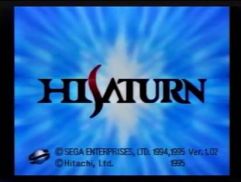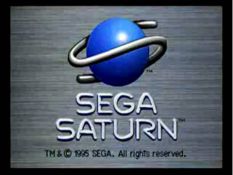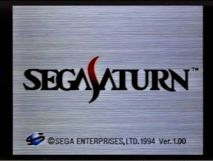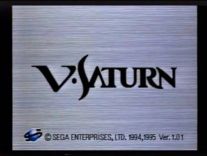Sega Saturn
Jump to navigation
Jump to search
Background: The Sega Saturn was a console created by Sega, released in Japan on November 22, 1994 (1995 in North America and Europe). It was originally developed with 2D games in mind; however, at the time of development, Sony's PlayStation quickly took the world by storm with its then-advanced 3D graphics. This led to Sega realizing their next console should include that, and they added a duplicate CPU and graphics card to the system; while while CPUs with multiple cores are extremely commonplace in consoles and PCs today, this wasn't as common at the time, and doing so caused the cost and difficulty of developing games for the system to rise. However, what really hurt the Saturn was Sega of America's shoddy treatment of the system. The console lacked a "killer app"; there was intended to be a mainline Sonic game released for the system, but due to miscommunication between Sega's Japanese and American studios as well as time constraints, it never wound up releasing (the system would instead see the racing game Sonic R and Genesis compilation Sonic Jam). Sega then attempted to one-up Sony in a really bad way; on the first day of the 1995 E3 on May 11,they announced at their exhibition that the Saturn would be released and shipped that day, instead of the planned "Saturnday" of September 2. This move angered retail stores and game developers, and left the Saturn with a series of weak launch titles, and it didn't help the console was priced at a hefty $399. (Famously, at Sony's exhibition, Steve Race walked up to the stage, said simply "$299", and walked off the stage to rapturous applause.) The final nail in the coffin was Sega hiring Bernie Stolar to replace the then-retired Tom Kalinske as an executive; he had an extremely stubborn policy that forbid 2D games (which are often regarded as some of the system's best titles, including Sakura Wars) and RPGs (which were gaining steady popularity at the time, especially with the release of Final Fantasy VII on the PlayStation) from being localized, and was previously fired from Sony for very similar reasons. While the system did very well in Japan, where it remains Sega's highest-selling console, it didn't do as well elsewhere, ultimately only selling 9.26 million units worldwide (for comparison, the PlayStation sold over 102 million units worldwide). Today, the Saturn is more often remembered for Sega's poor treatment and management of the system, but it still maintains a loyal fanbase, and Sega aimed to avoid the mistakes they made with the Saturn on their next (and final) console, the Dreamcast.
1st Logo
Logo: On a black background, we see pieces of glass flying all over the screen. Suddenly, the camera takes a sharp turn to the left, and the pieces of glass form an abstract "SEGA SATURN", with the second "S" being larger than the rest of the letters and the top half is red, and both "A"s not containing a horizontal line between the legs. When it's finished, a bright light flashes, turning the black background into a steel gray background, and in the bottom left corner, a small blue ball with a black S-shaped ring surrounding it, next to a copyright-- "(c) SEGA ENTERPRISES, LTD. 1994 Ver. 1.00" all appear.
Variants:
FX/SFX: The glass, camera movements, flash and the metallic background, which are all in real-time.
Music/Sounds: Three rising synthesized notes, with the sound of glass breaking at the beginning, and a synth warble (if there's no game in the console).
Availability: Uncommon. This appears when you turn on an NTSC-J (Japanese) Sega Saturn console. Rare for the V-Saturn variant, as it was also a Japanese exclusive.
Editor's Note: This is a favorite among Sega fans. The regular variant also makes an appearance on the Sega Films logo from Sonic the Hedgehog.
1st Logo
(November 22, 1994-December 4, 2000)
<embed height="161" src="http://wikifoundrytools.com/wiki/closinglogos/page/Sega+Saturn/widget/youtubevideo/-558345917" type="application/x-shockwave-flash" width="197" wmode="transparent"/><embed height="162" src="http://wikifoundrytools.com/wiki/closinglogos/page/Sega+Saturn/widget/youtubevideo/1150811894" type="application/x-shockwave-flash" width="195" wmode="transparent"/>
Logo: On a black background, we see pieces of glass flying all over the screen. Suddenly, the camera takes a sharp turn to the left, and the pieces of glass form an abstract "SEGA SATURN", with the second "S" being larger than the rest of the letters and the top half is red, and both "A"s not containing a horizontal line between the legs. When it's finished, a bright light flashes, turning the black background into a steel gray background, and in the bottom left corner, a small blue ball with a black S-shaped ring surrounding it, next to a copyright-- "(c) SEGA ENTERPRISES, LTD. 1994 Ver. 1.00" all appear.
Variants:
- If you press a button (mainly Start) while the startup is playing, the animation would skip to the flash and the music fades out. This also happens with the rest of the other startups.
- On JVC-made systems (called Victor Saturn), the pieces of glass move differently and the logo reads "V-SATURN" instead (with an entirely black "S"). It has the same music mentioned below. Also, the copyright reads "(c) SEGA ENTERPRISES, LTD. 1994, 1995 Ver. 1.01".
FX/SFX: The glass, camera movements, flash and the metallic background, which are all in real-time.
Music/Sounds: Three rising synthesized notes, with the sound of glass breaking at the beginning, and a synth warble (if there's no game in the console).
Availability: Uncommon. This appears when you turn on an NTSC-J (Japanese) Sega Saturn console. Rare for the V-Saturn variant, as it was also a Japanese exclusive.
Editor's Note: This is a favorite among Sega fans. The regular variant also makes an appearance on the Sega Films logo from Sonic the Hedgehog.
2nd Logo
(1994?-2000?)
 <embed align="bottom" height="181" src="http://wikifoundrytools.com/wiki/closinglogos/page/Sega+Saturn/widget/youtubevideo/1841505098" type="application/x-shockwave-flash" width="220" wmode="transparent"/>
<embed align="bottom" height="181" src="http://wikifoundrytools.com/wiki/closinglogos/page/Sega+Saturn/widget/youtubevideo/1841505098" type="application/x-shockwave-flash" width="220" wmode="transparent"/>
Note: This is an alternate logo that appeared on Hitachi's Hi-Saturn console.
Logo: On a space background, we see two mirrored images of an odd shape zooming in towards us, rotating into place as they do so. They pass us, but a few seconds later, return, and it's revealed to be the text "HI-SATURN", colored gold. When the logo's in place, a bright flash can be seen, turning the 3D "HI-SATURN" into a 2D version, and the space background becomes a blue starburst-sky background. As in the previous logo, the small Saturn logo appears on the bottom left, but now, there are TWO copyrights next to the small Saturn logo-- "(c) SEGA ENTERPRISES, LTD. 1994, 1995 Ver. 1.02" and "(c) Hitachi, Ltd. 1995" below that.
FX/SFX: All the animation in the logo, which again is all in real time.
Music/Sounds: An ascending synthesized sounder, then a harmonic synth choir is heard. Again, if there's no game in the console, the same synth warble on the Sega Saturn/V-Saturn plays.
Availability: Extremely rare, appears on Hitachi's Hi-Saturn console from Sega. But unfortunately, this is only sold in Japan. You can look on eBay for Hi-Saturn consoles, but the prices are quite high.
Editor's Note: This is another favorite of many.
3rd Logo
(May 11, 1995-1999)
 <embed allowfullscreen="true" height="186" src="http://wikifoundrytools.com/wiki/closinglogos/widget/youtubevideo/a28cbdad9aa7398b10bdebb6aae5e38ca5e3147f" type="application/x-shockwave-flash" width="224" wmode="transparent"/>Logo: It has the same background and the same pieces of glass as the first logo, but the pieces of glass move differently and form the Saturn logo (blue ball with a S-shaped ring) , but this time bigger and above the SEGA SATURN text, and with the ring silver instead of black. "SEGA SATURN", stacked, can be seen below the logo after the flash. Below the text, we see the copyright "TM & (c) 1995 SEGA. All rights reserved."
<embed allowfullscreen="true" height="186" src="http://wikifoundrytools.com/wiki/closinglogos/widget/youtubevideo/a28cbdad9aa7398b10bdebb6aae5e38ca5e3147f" type="application/x-shockwave-flash" width="224" wmode="transparent"/>Logo: It has the same background and the same pieces of glass as the first logo, but the pieces of glass move differently and form the Saturn logo (blue ball with a S-shaped ring) , but this time bigger and above the SEGA SATURN text, and with the ring silver instead of black. "SEGA SATURN", stacked, can be seen below the logo after the flash. Below the text, we see the copyright "TM & (c) 1995 SEGA. All rights reserved."
Trivia: This logo was used at the end of various adverts for Sega Saturn games in the UK in the later 1990's.
Variant: A piece of text would fly by the screen halfway through the logo animation. This text was usually a hint or cheat for the game advertised (E.G. adverts for Sonic R told the player how to unlock Super Sonic)
FX/SFX: The pieces of glass flying around and forming the logo.
Music/Sounds: A synthesized "twinkling" chime-organ tune, followed by a whoosh, then what sounds like a jail cell door closing.
Music/Sounds Variant: A voice-over saying or yelling "Sega" at the end of it. The VA varied advert by advert, but adverts for any of the Sonic games used the classic "SEGA!" tune.
Availability: Common. This appears when you turn on an NTSC-US (North American) or PAL (European or Australian) Saturn console.
Editor's Note: A good take on the Japanese startup, along with its animation and calming theme makes this logo another favorite.
(1994?-2000?)
 <embed align="bottom" height="181" src="http://wikifoundrytools.com/wiki/closinglogos/page/Sega+Saturn/widget/youtubevideo/1841505098" type="application/x-shockwave-flash" width="220" wmode="transparent"/>
<embed align="bottom" height="181" src="http://wikifoundrytools.com/wiki/closinglogos/page/Sega+Saturn/widget/youtubevideo/1841505098" type="application/x-shockwave-flash" width="220" wmode="transparent"/>Note: This is an alternate logo that appeared on Hitachi's Hi-Saturn console.
Logo: On a space background, we see two mirrored images of an odd shape zooming in towards us, rotating into place as they do so. They pass us, but a few seconds later, return, and it's revealed to be the text "HI-SATURN", colored gold. When the logo's in place, a bright flash can be seen, turning the 3D "HI-SATURN" into a 2D version, and the space background becomes a blue starburst-sky background. As in the previous logo, the small Saturn logo appears on the bottom left, but now, there are TWO copyrights next to the small Saturn logo-- "(c) SEGA ENTERPRISES, LTD. 1994, 1995 Ver. 1.02" and "(c) Hitachi, Ltd. 1995" below that.
FX/SFX: All the animation in the logo, which again is all in real time.
Music/Sounds: An ascending synthesized sounder, then a harmonic synth choir is heard. Again, if there's no game in the console, the same synth warble on the Sega Saturn/V-Saturn plays.
Availability: Extremely rare, appears on Hitachi's Hi-Saturn console from Sega. But unfortunately, this is only sold in Japan. You can look on eBay for Hi-Saturn consoles, but the prices are quite high.
Editor's Note: This is another favorite of many.
3rd Logo
(May 11, 1995-1999)
 <embed allowfullscreen="true" height="186" src="http://wikifoundrytools.com/wiki/closinglogos/widget/youtubevideo/a28cbdad9aa7398b10bdebb6aae5e38ca5e3147f" type="application/x-shockwave-flash" width="224" wmode="transparent"/>
<embed allowfullscreen="true" height="186" src="http://wikifoundrytools.com/wiki/closinglogos/widget/youtubevideo/a28cbdad9aa7398b10bdebb6aae5e38ca5e3147f" type="application/x-shockwave-flash" width="224" wmode="transparent"/>Trivia: This logo was used at the end of various adverts for Sega Saturn games in the UK in the later 1990's.
Variant: A piece of text would fly by the screen halfway through the logo animation. This text was usually a hint or cheat for the game advertised (E.G. adverts for Sonic R told the player how to unlock Super Sonic)
FX/SFX: The pieces of glass flying around and forming the logo.
Music/Sounds: A synthesized "twinkling" chime-organ tune, followed by a whoosh, then what sounds like a jail cell door closing.
Music/Sounds Variant: A voice-over saying or yelling "Sega" at the end of it. The VA varied advert by advert, but adverts for any of the Sonic games used the classic "SEGA!" tune.
Availability: Common. This appears when you turn on an NTSC-US (North American) or PAL (European or Australian) Saturn console.
Editor's Note: A good take on the Japanese startup, along with its animation and calming theme makes this logo another favorite.

